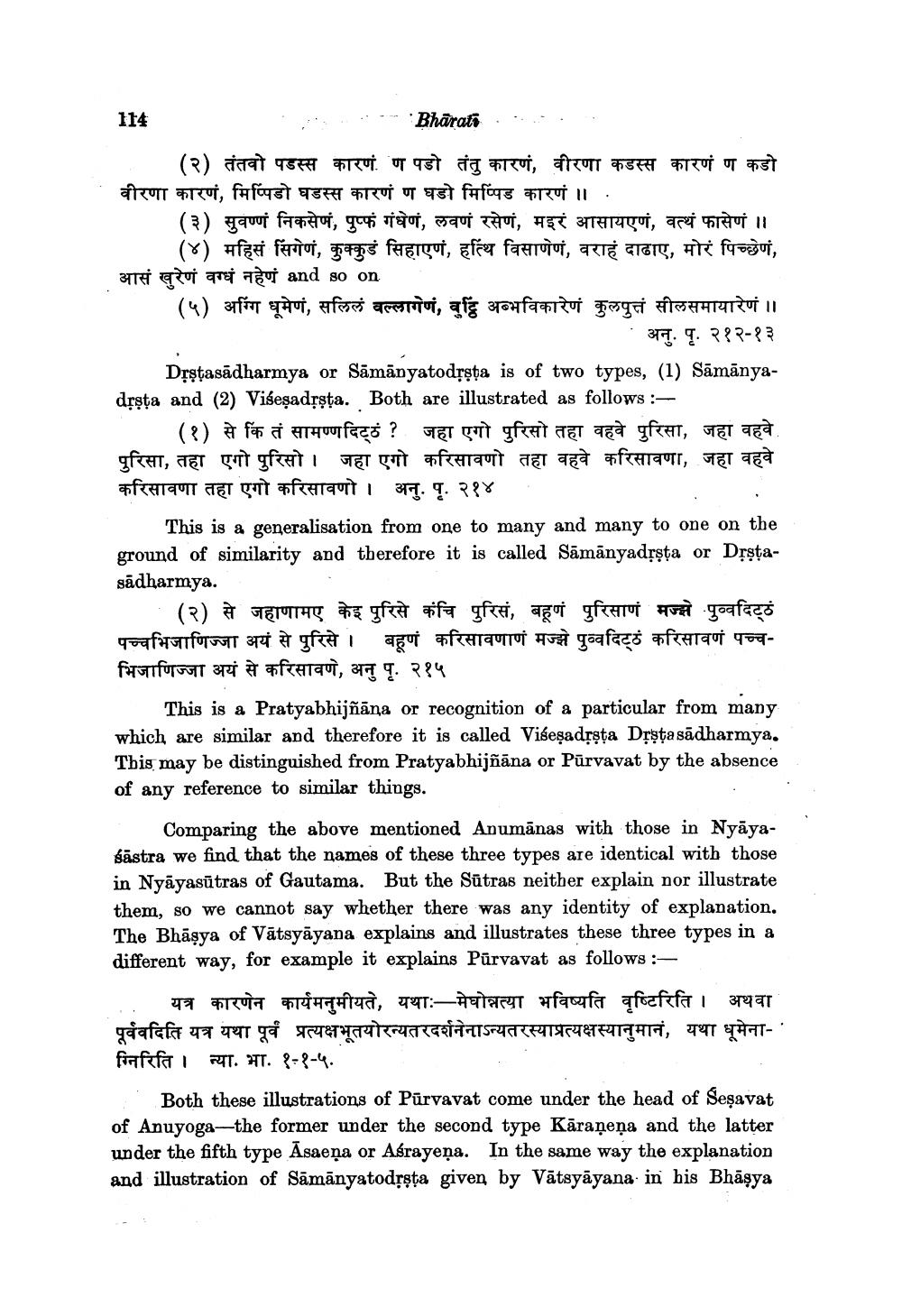________________
114
Bhārati (२) तंतवो पडस्स कारणं. ण पडो तंतु कारणं, वीरणा कडस्स कारणं ण कडो वीरणा कारणं, मिप्पिडो घडस्स कारणं ण घडो मिप्पिड कारणं ॥ .
३) सुवण्णं निकसेणं, पुप्फ गंधेणं, लवणं रसेणं, मइरं आसायएणं, वत्थं फासेणं ॥
(४) महिसं सिंगेणं, कुक्कुडं सिहाएणं, हत्थि विसाणेणं, वराहं दाढाए, मोरं पिच्छेणं, आसं खुरेणं वग्धं नहेणं and so on (५) अग्गि धूमेणं, सलिलं वल्लागणं, वुद्धि अब्भविकारेणं कुलपुत्तं सीलसमायारेणं ॥
- अनु. पृ. २१२-१३ Drstasādharmya or Samanyatodrsha is of two types, (1) Sāmānyadrsta and (2) Visesadrsta. Both are illustrated as follows :
(१) से किं तं सामण्णदिळं ? जहा एगो पुरिसो तहा वहवे पुरिसा, जहा वहवे पुरिसा, तहा एगो पुरिसो। जहा एगो करिसावणो तहा वहवे करिसावणा, जहा वहवे करिसावणा तहा एगो करिसावणो। अनु. पृ. २१४
This is a generalisation from one to many and many to one on the ground of similarity and therefore it is called Sāmānyadựşta or Dșstasādharmya.
(२) से जहाणामए केइ पुरिसे कंचि पुरिसं, बहूणं पुरिसाणं मज्झे पुव्वदिटुं पच्चभिजाणिज्जा अयं से पुरिसे। बहूणं करिसावणाणं मज्झे पुव्वदिह्र करिसावणं पच्चभिजाणिज्जा अयं से करिसावणे, अनु पृ. २१५
This is a Pratyabhijñāna or recognition of a particular from many which are similar and therefore it is called Višeşadsşta Drşțasādharmya. This may be distinguished from Pratyabhijñāna or Pūrvavat by the absence of any reference to similar things.
Comparing the above mentioned Anumānas with those in Nyāyaśāstra we find that the names of these three types are identical with those in Nyāyasūtras of Gautama. But the Sūtras neither explain nor illustrate them, so we cannot say whether there was any identity of explanation. The Bhāşya of Vātsyāyana explains and illustrates these three types in a different way, for example it explains Pūrvavat as follows:
यत्र कारणेन कार्यमनुमीयते, यथाः-मेघोन्नत्या भविष्यति वृष्टिरिति । अथवा पूर्ववदिति यत्र यथा पूर्व प्रत्यक्षभूतयोरन्यतरदर्शनेनाऽन्यतरस्याप्रत्यक्षस्यानुमानं, यथा धूमेनाग्निरिति । न्या. भा. १-१-५.
Both these illustrations of Pūrvavat come under the head of Sesavat of Anuyoga—the former under the second type Kāraņeņa and the latter under the fifth type Asaeņa or Aśrayeņa. In the same way the explanation and illustration of Sāmānyatodrsta given by Vātsyāyana in his Bhāşya




